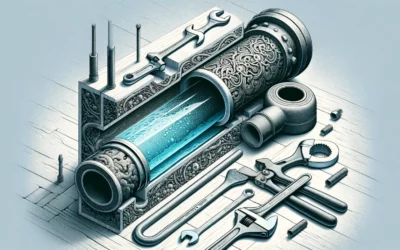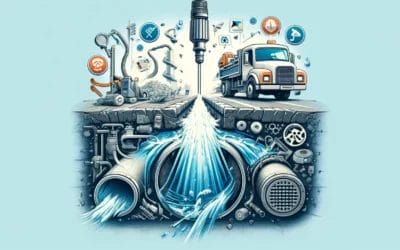Welcome to our educational and informative post on “Understanding the Causes of Water in Your Natural Gas Line”. Through this helpful guide, we aim to provide in-depth expert opinion and fact-based information on an often overlooked issue that many homeowners face. Whether you are curious about how water ended up in your natural gas line, or you’re looking for practical solutions to rectify the situation, this post serves as an invaluable resource. We strive to make complex problems easy to understand, enabling you to take the appropriate steps to ensure your home remains safe, efficient and damage-free. So let’s explore the causes together and educate ourselves on this crucial issue.
Understanding the Basics: Water Presence in Your Natural Gas Line
The introduction of moisture or water into your natural gas line can lead to a myriad of issues, including corrosion, reduced efficiency, and even damage to the entire gas system. While it may be a common problem for homeowners and businesses, understanding its causes can equip you to take proper preventive measures. Two of the primary reasons you may find water in your natural gas line are condensation and leaks.
Condensation is a natural process where gas turns into liquid when it comes into contact with a cold surface. Gas pipelines often run underground where temperatures can be significantly cooler than the gas itself, which leads to the formation of condensation inside the pipes. This water subsequently gets mixed with your natural gas. This not only reduces the energy value of the gas but also causes internal corrosion in your pipes over time.
Leaks in your natural gas line can introduce water from the surrounding soil or from rainwater. These leaks could either be due to poor quality pipes, incorrect pipe installation, or physical damage to the pipes. Additionally, underground pipelines often pass through areas with high groundwater. If there’s a leak or crack in the pipe, this groundwater can seep in and mix with the gas. Leaks pose a more severe threat as they not only allow water in but also let the gas out - posing a major safety hazard.
| Causes | Effects |
|---|---|
| Condensation | Reduced energy efficiency, Internal corrosion |
| Leaks | Potential safety hazard, water contamination from surrounding areas |
Awareness about these root causes can be instrumental in avoiding the problems posed by the presence of water in your natural gas line. It’s prudent to regularly inspect your gas lines for any signs of condensation or leaks. For thorough inspections, getting professional help is highly recommended as they have the required equipment and expertise to detect and fix any issue before it escalates.

Diagnostic Guide: Identifying Water in Your Gas Line
Detecting Signs of Water Contamination
The first step in combating water in your gas line is identifying the problem. Typical signs of water in the gas line can include a blue flame turning yellow or orange, issues with starting the ignition, an unusual smell similar to rotten eggs, and a drop in your gas pressure. These changes in your appliances’ performance could indicate a water intrusion. If your gas-powered appliances are showing these signs, it might be high time to consult an expert.
List of Signs of Water in Gas Line
- Blue flame turning yellow or orange
- Difficulty in starting the ignition
- Presence of unusual, foul smell
- Drop in gas pressure
Primary Causes and the Associated Risks
Understanding the potential causes for water in your gas line contributes to better prevention. Primarily, water gets into the gas lines as a result of condensation from high humidity or due to leakage in the gas line system, which allows for rainwater infiltration. Additionally, damaged or old pipes could also be a reason because they might not be fully sealed anymore.
Apart from impacting your appliances’ performance, presence of water in your gas line can be a serious safety hazard. In the worst-case scenario, water in the gas line can cause a gas leak which could potentially result in an explosion.
Table: Causes and Effects of Water in Gas Line
Cause Effect Condensation due to high humidity Drop in gas pressure, damages to the appliances Leaks in gas line Increased risk of gas leak, potential explosion Damaged or old pipes Compromised safety, reduced longevity of appliances
In essence, careful monitoring of your gas appliances’ performance and regular maintenance of your gas line system can help you prevent water infiltration. Consequently, this not only ensures the efficient operation of your household appliances but also secures your family’s safety.

Investigating the Common Causes: How Water Enters Your Natural Gas Line
While one might not immediately associate water with a natural gas line, it can prove to be surprisingly detrimental to its performance. Moisture infiltration in your gas line may cause rusting and corrosion, equipment malfunctions, and even dangerous leaks. Getting to the root of the problem starts with understanding the most common causes how this water gets into your line in the first place.
Firstly, a key culprit can be condensation. Gas lines typically run through cooler areas of your house, such as basements or unfinished sections. When warm, humid air comes into contact with these cooler pipes, condensation forms that can trickle down into your line. Secondly, a lack of a proper vapor barrier can cause moisture infiltration. This is a material that blocks moisture from seeping into your gas line. When absent or improperly installed, it can invite a significant amount of water into your pipeline.
| Cause | Description |
|---|---|
| Condensation | Water droplets form when warm, humid air comes into contact with cooler pipes. |
| Lack of a proper vapor barrier | Water seepage can take place when the material that prevents moisture from entering the gas line is either absent or incorrectly installed. |
The third common cause is from groundwater infiltration. If your gas line was installed close to the water table or there is poor drainage around the line, groundwater may leak into it. Lastly, flaws in the pipeline construction such as breaks or gaps in the piping can be a direct entry point for water.
| Cause | Description |
|---|---|
| Groundwater infiltration | If the gas line was installed near the water table or has insufficient drainage around it, groundwater may seep in. |
| Flaws in pipeline construction | Breaks, gaps or cracks in the piping can allow water to permeate directly into the line. |
Implications and Effects: The Consequences of Water in Your Gas Line
The presence of water in your gas line can cause significant challenges if not promptly addressed. The implications are not just limited to functionality, but they also touch on safety, economic, and environmental aspects. Firstly, the water in the gas line can cause corrosion – a dangerous consequence that may lead to gas leaks. It’s known that natural gas is highly flammable, and thus, a leak poses an immense safety risk. Next, the presence of water can lead to damage to appliances that utilize natural gas, due to reduced heat output. This incurs repair or replacement costs, making it an economical issue.
- Corrosion risks: Over time, water and moisture can cause corrosion in your gas lines, leading to possible leaks.
- Appliance damage: Micro droplets of water in the gas line reduce the heat output, affecting the efficiency and lifespan of your appliances.
| Problem | Consequence |
|---|---|
| Water in Gas Line | Potential for gas leaks due to corrosion |
| Water in Gas Line | Reduced appliance efficiency and lifespan |
Another crippling effect is the possibility of pipeline blockages. During the cold season, the water in the gas line can freeze and form an obstruction, leading to a significant reduction or complete cut-off of the gas supply. Which in effect, means no heat, cooking gas or hot water until the problem is resolved. Lastly, moisture in the pipelines can also lead to an increase in the emission of greenhouse gases. When pipelines corrode, they tend to release methane, a potent greenhouse gas, contributing significantly to global warming.
- Pipeline blockage: Water can freeze in the gas lines during cold seasons, causing a block or disruption of gas supply.
- Increased greenhouse gas emissions: Corroded pipelines release methane, a potent greenhouse gas that contributes to global warming.
| Problem | Consequence |
|---|---|
| Water in Gas Line | Possible blockage of the pipeline, particularly during the cold season |
| Water in Gas Line | Increased greenhouse gas emissions due to corroded pipelines |
Experts Speak: Professional Insights on Water Accumulation in Natural Gas Lines
The presence of water in gas lines can cause serious problems such as line blockage, corrosion, and operational inefficiencies. A better understanding of its causes can lead to more effective prevention and treatment strategies. Water can be present in natural gas lines primarily as a result of condensation and gas extraction processes.
Condensation is typically the most common cause of water accumulation in gas lines. When warm natural gas comes into contact with a cold pipe surface, it causes the gas to condense and form water droplets. Additionally, the gas extraction process can also be reservoirs of water, especially if the gas wells are located in areas of high groundwater levels. Steam-assisted extraction methods can also introduce additional water into the gas lines.
The following table illustrates common sources of water in natural gas lines:
| Source | Description |
|---|---|
| Condensation | Natural gas that’s cooled in the gas lines can transform into water due to condensation. |
| Extraction Process | Gas wells in areas with high groundwater levels or using steam-assisted extraction methods can introduce water into the gas lines. |
Preventing water formation in your natural gas line is essential to avoid operational problems. Regular inspection, proper insulation of pipelines, and effective water removal techniques should be part of your strategy to maintain your natural gas lines. Also, innovations in technology are providing new and promising solutions to this age-old problem. Therefore, keeping up-to-date with the latest trends and improvements in this field is also crucial.
Practical Solutions: Preventing Water Intrusion in Your Gas Pipeline
Addressing Water Intrusion in Gas Pipelines In the quest to ensure the integrity of your gas pipeline, it is imperative to incorporate periodic maintenance practices. One of the key threats often plaguing natural gas lines is water intrusion. Moisture within the lines not only hampers the optimal functioning of your gas appliances but can also exponentially multiply the chances of pipeline corrosion.
Preventive Measures
- Keep your pipeline pressurized:Maintaining an optimum pressure level within the lines can ward off the incursion of external water into your gas pipeline. Regular checks for pressure drops can prove beneficial.
- Use of chemical inhibitors:A chemical inhibitor can effectively reduce pipeline corrosion leading to a decreased chance of water intrusion.
- Regular inspections:It is necessary to carry out regular inspections in order to detect any potential sources of leaks which can pave the way for water intrusion.
Adopting Technological Innovations for Improved Functioning The influx of technology within pipeline management and maintenance aids in reducing the chances of water intrusion. Among the frontrunners of these advancements, we find solutions such as applying pipeline coatings and liners, and deploying corrosion monitoring devices.
Technological Solutions
| Pipeline Coatings and Liners | Use modern coating materials like epoxy, polyethylene etc. that provide a robust and waterproof barrier for the pipeline. |
| Corrosion Monitoring Devices | These devices will alert you in real-time when corrosion starts occurring in the pipelines, enabling timely intervention. |
While no single solution can guarantee complete prevention of water intrusion into gas pipelines, a comprehensive approach involving regular maintenance, preventive measures, and the effective use of technology can certainly enhance the durability and efficiency of your natural gas line.
Navigating Repair Options: Getting Professional Help for Water in Your Gas Line
In many cases, water in the gas line may be a problem too complex for a property owner to handle on their own. Professional help for water in gas line can simplify this process immensely. Well-equipped and experienced, professionals in this field offer comprehensive solutions. They will carry out accurate diagnoses and execute effective remedial measures to restore the functionality of your gas lines. Plus, professionals can ensure the safety and prolong the life of your gas lines. Hiring professionals typically involves three main steps;
- Initial Inspection and diagnosis
- Repair or replacement
- Scheduled maintenance
During the initial inspection, professionals carefully examine your gas lines for symptoms of water intrusion. The diagnosis allows them to identify the source of water in your gas line. Post-evaluation, they strategize a market-worthy solution tailored to suit your specific needs.
The technical process of water removal, the repair will rely on the severity of the problem and the diagnosis. The professional might repair the impacted section of your gas line or suggest a prompt replacement. Your chosen professional will carry out the necessary work, ensuring optimal safety measures are intact. Lastly, professionals usually offer a scheduled maintenance program, ensuring your gas lines remain water-free in the long term.
| Problem | Professional Solution |
| Water in gas line | Inspection and diagnosis |
| Irreparable Gas Line | Replacement |
| Recurring Water Issues | Scheduled maintenance |
So if you notice signs of water in your gas line, your safest and most effective solution is to seek professional help. With their expertise and specialized tools, they’ll ensure any water issues are promptly addressed and your gas lines remain fully operational and safe in the long run. Don’t delay, call a professional today!
Key Takeaways
In conclusion, understanding the causes of water in your natural gas line can help you identify and address the problem promptly. It stems from the natural condensation process, improper pipeline installations, and even environmental factors. With the knowledge gained from this article, you can take informed steps in inspection, maintenance, and repair. However, engagement with skilled professionals is greatly advised and can be crucial in situations related to gas lines. Remember, preventive measures taken well in time saves significant future troubles and costs. Keep learning, stay informed, and ensure the safety and stability of your gas supply lines.









